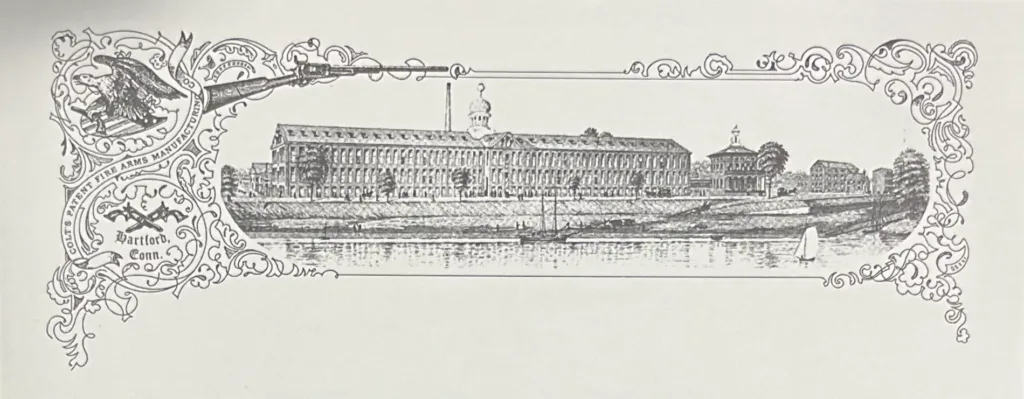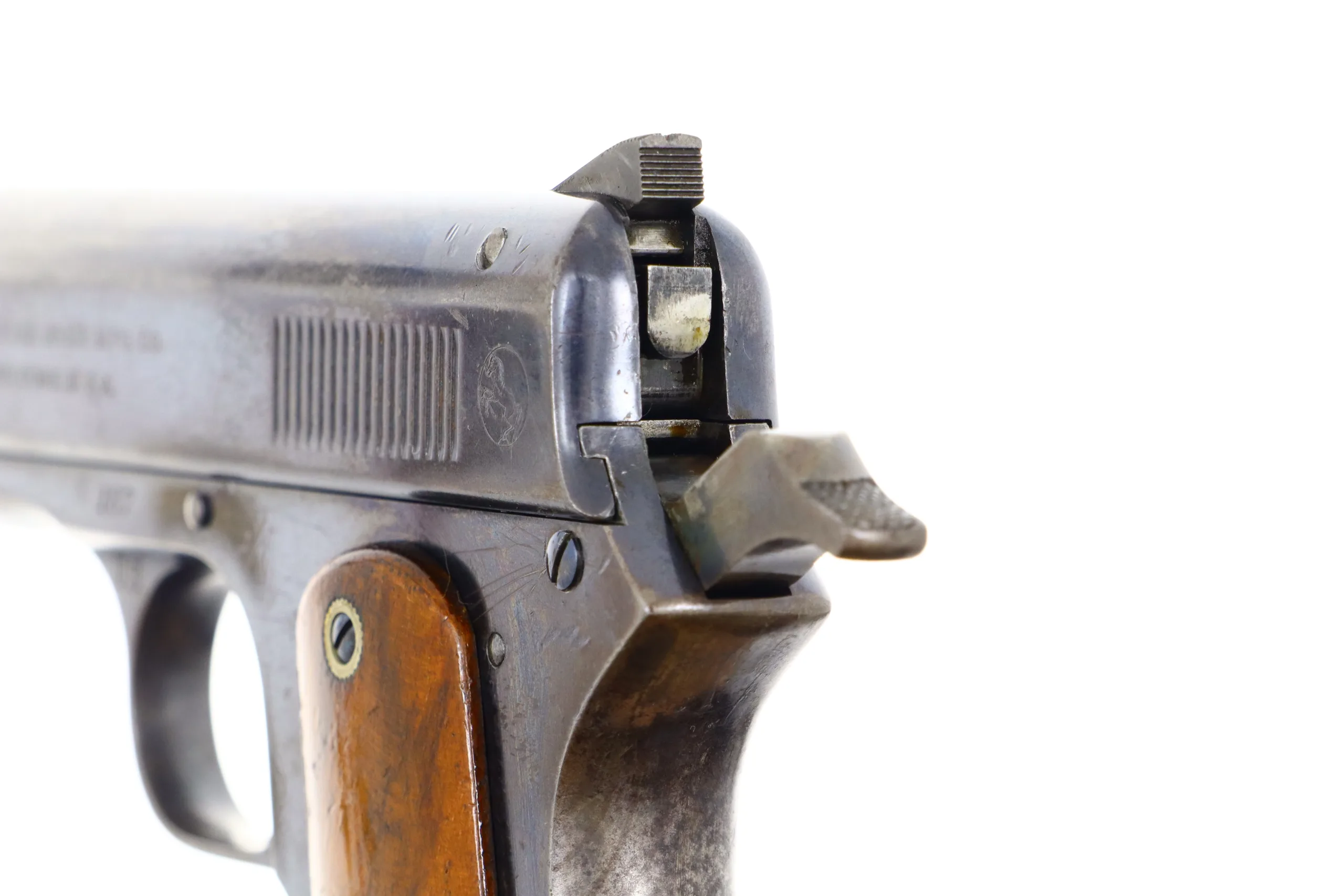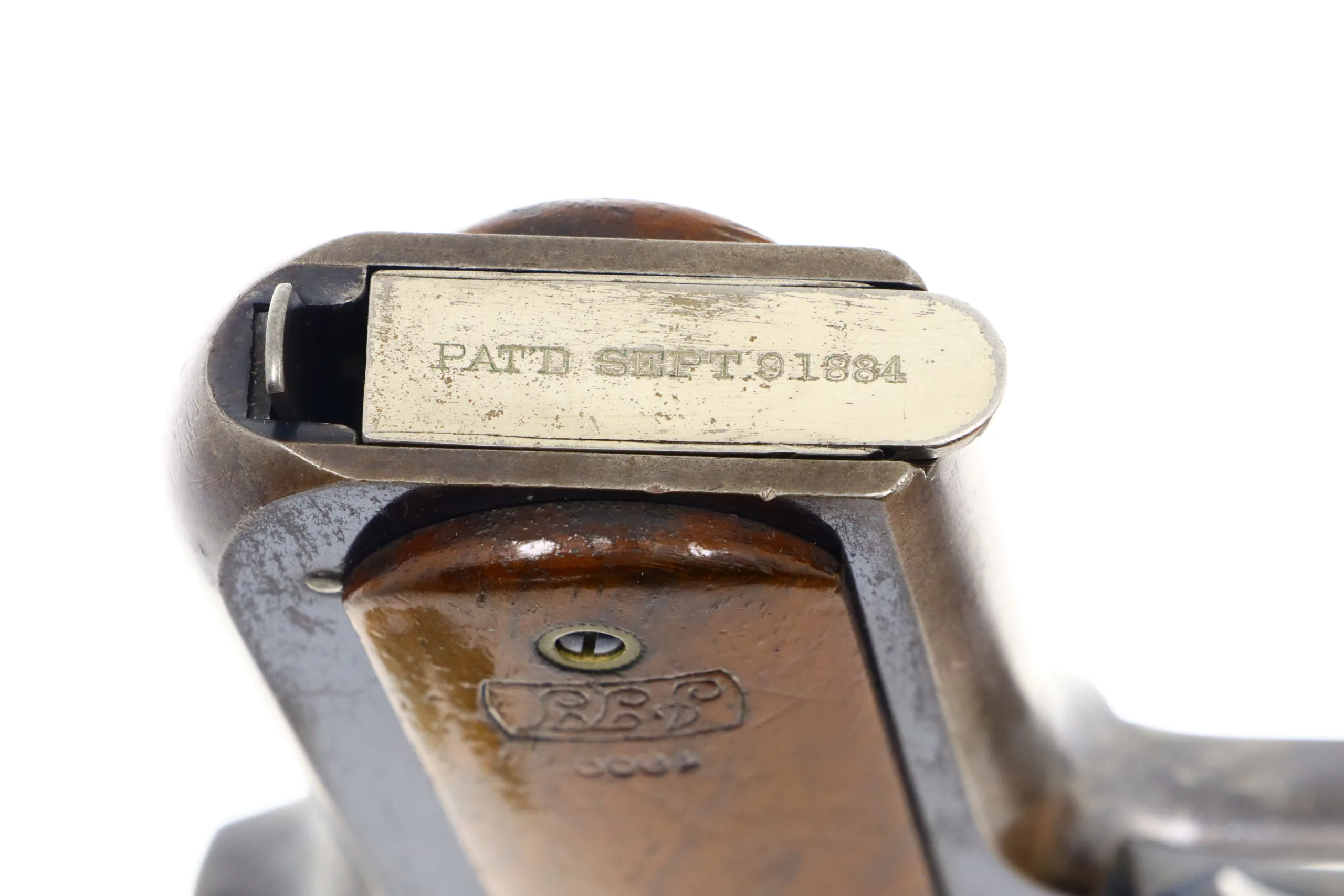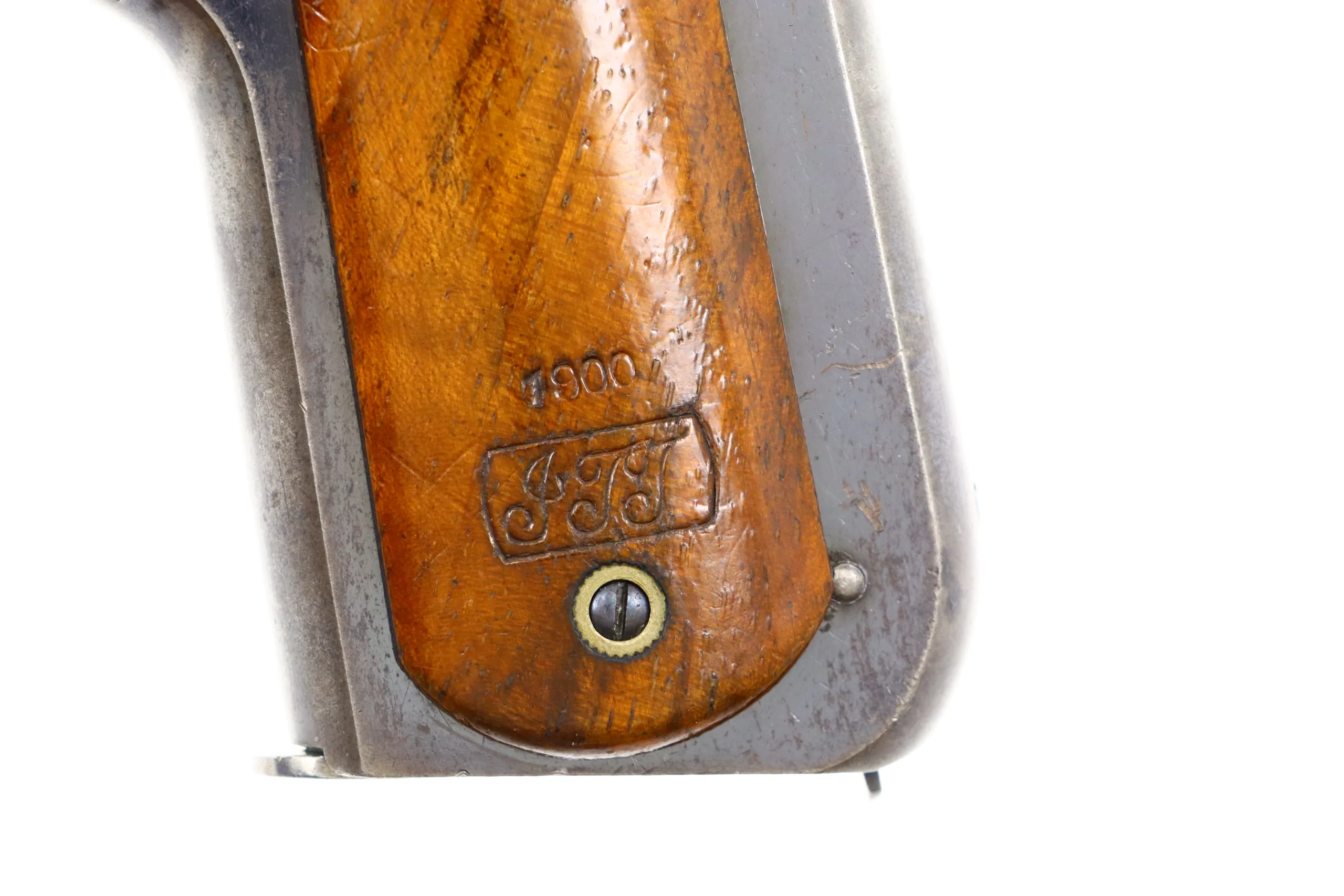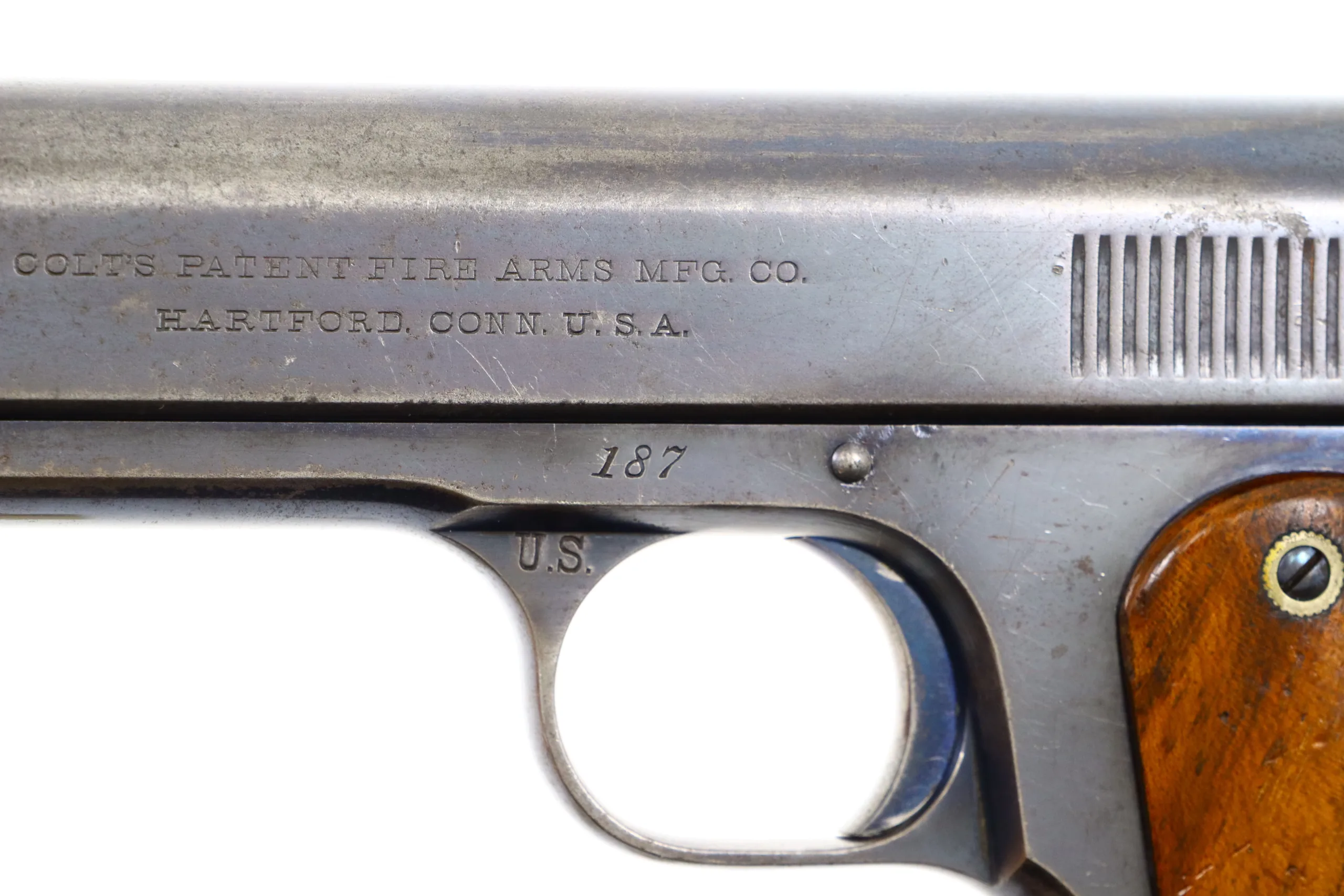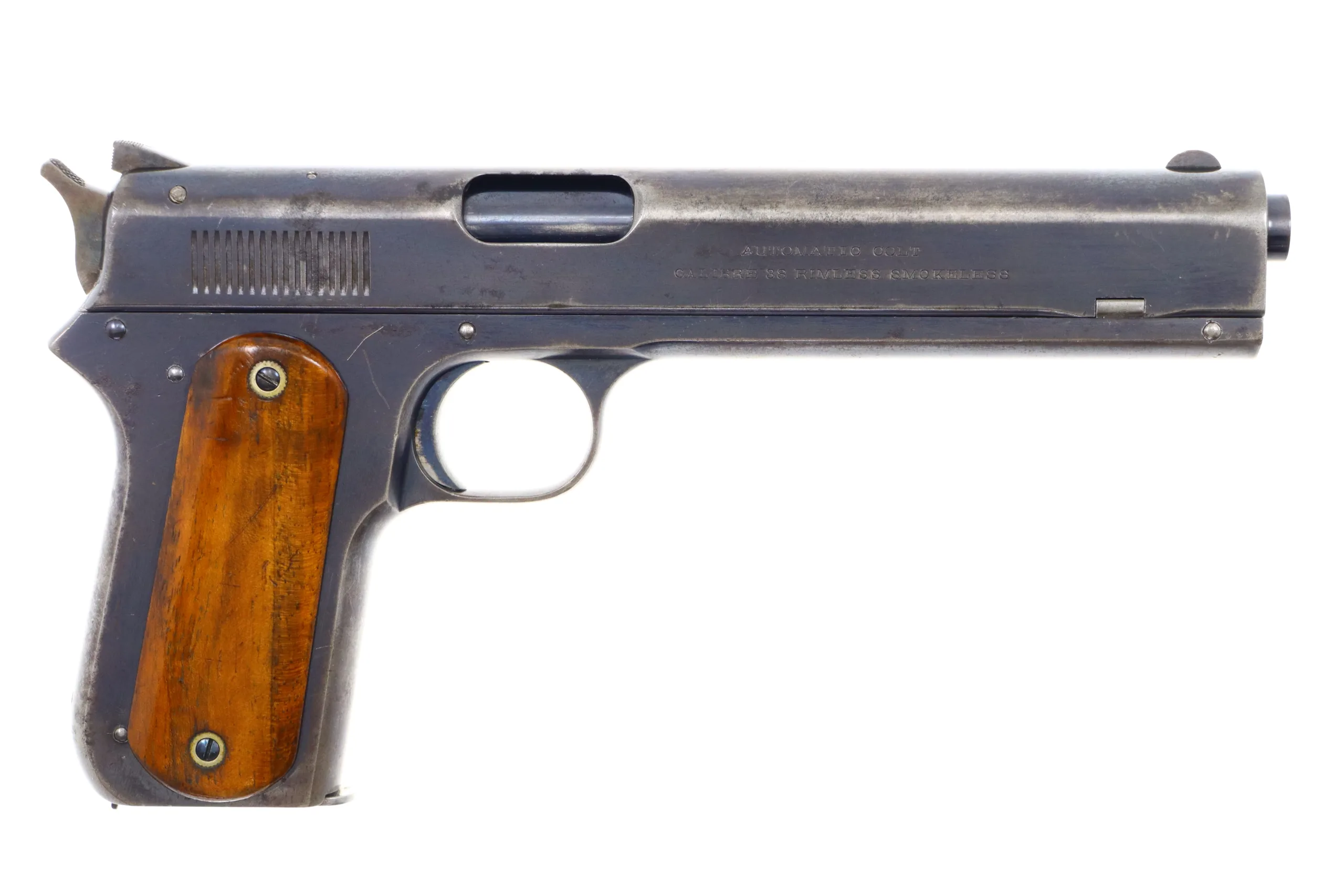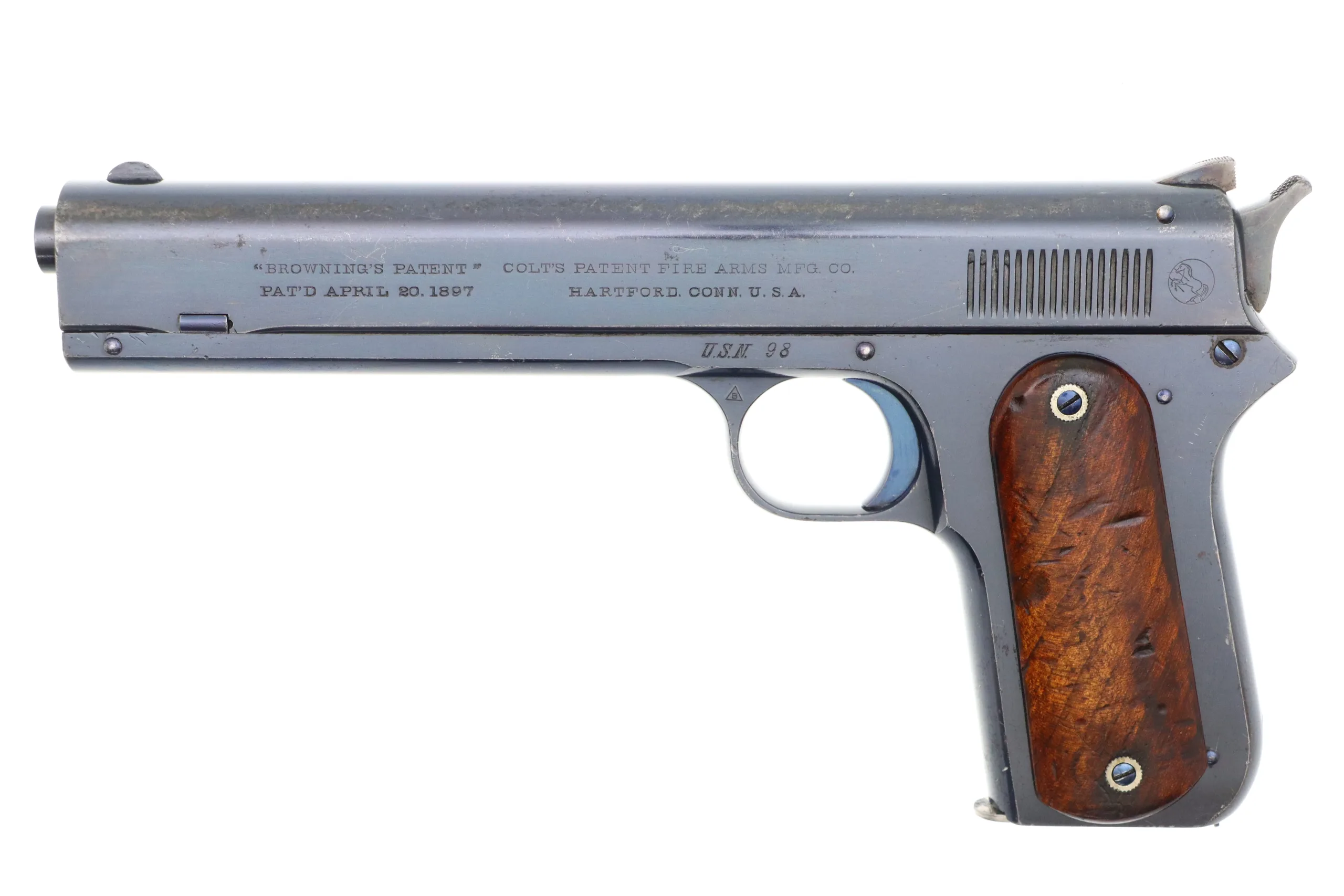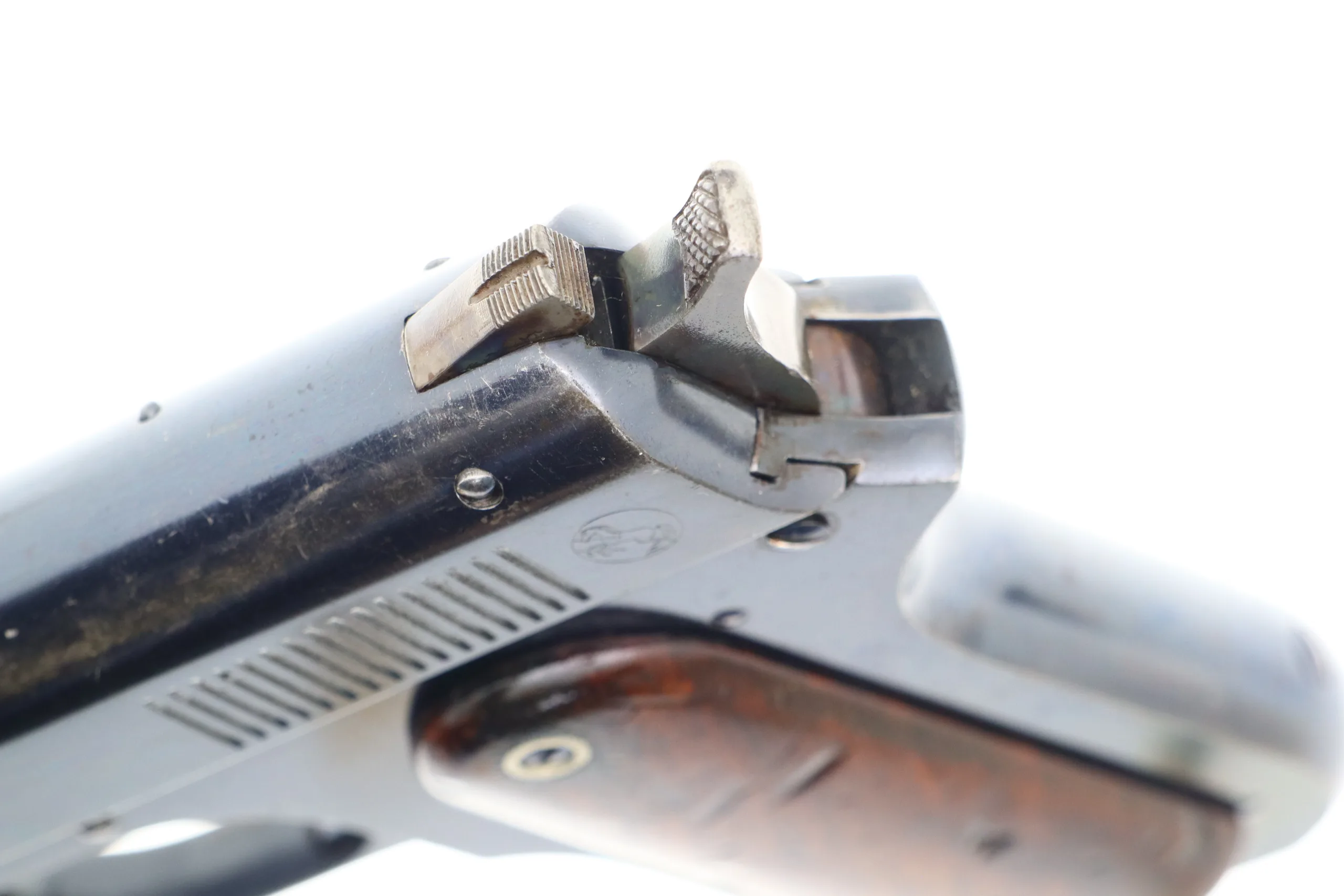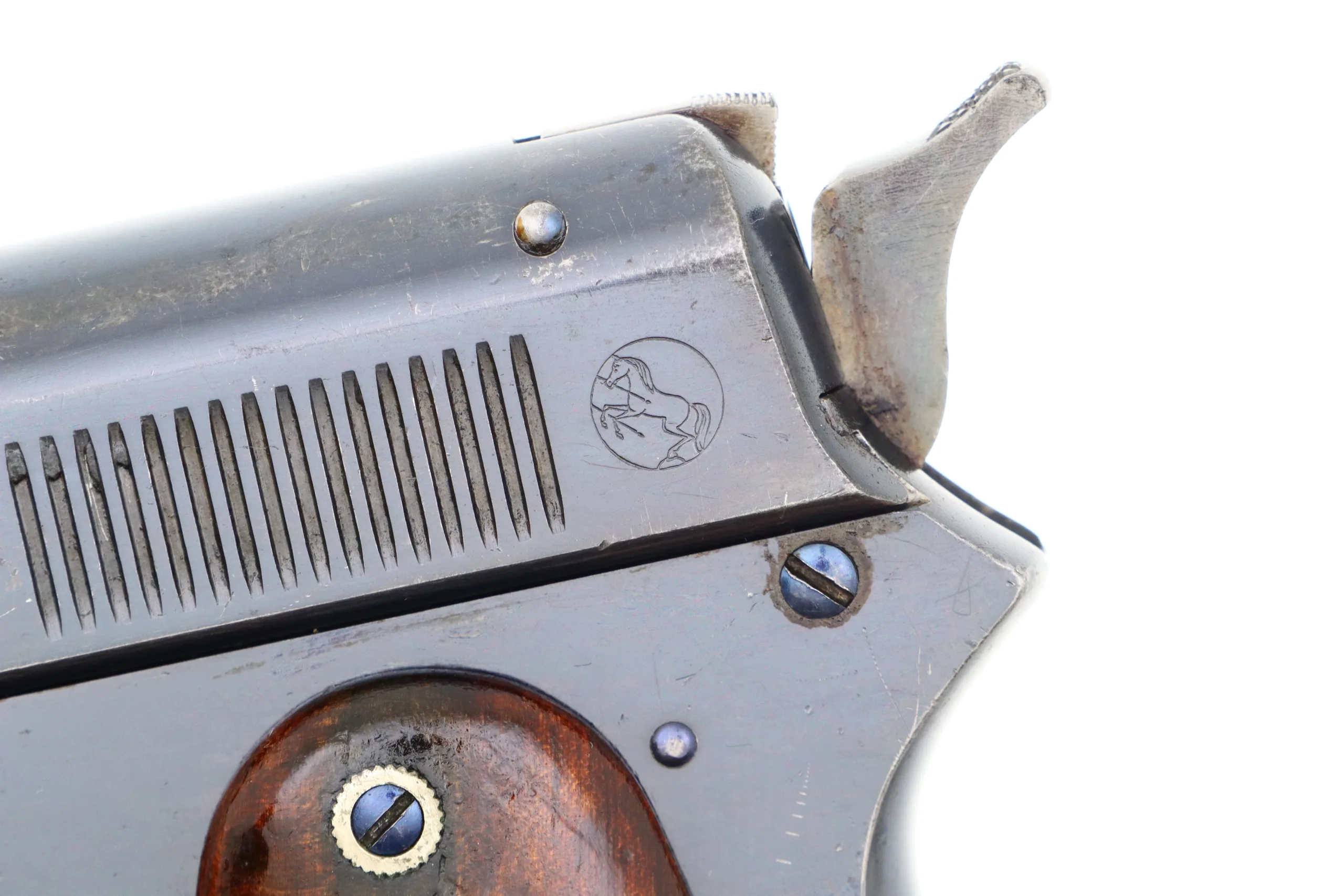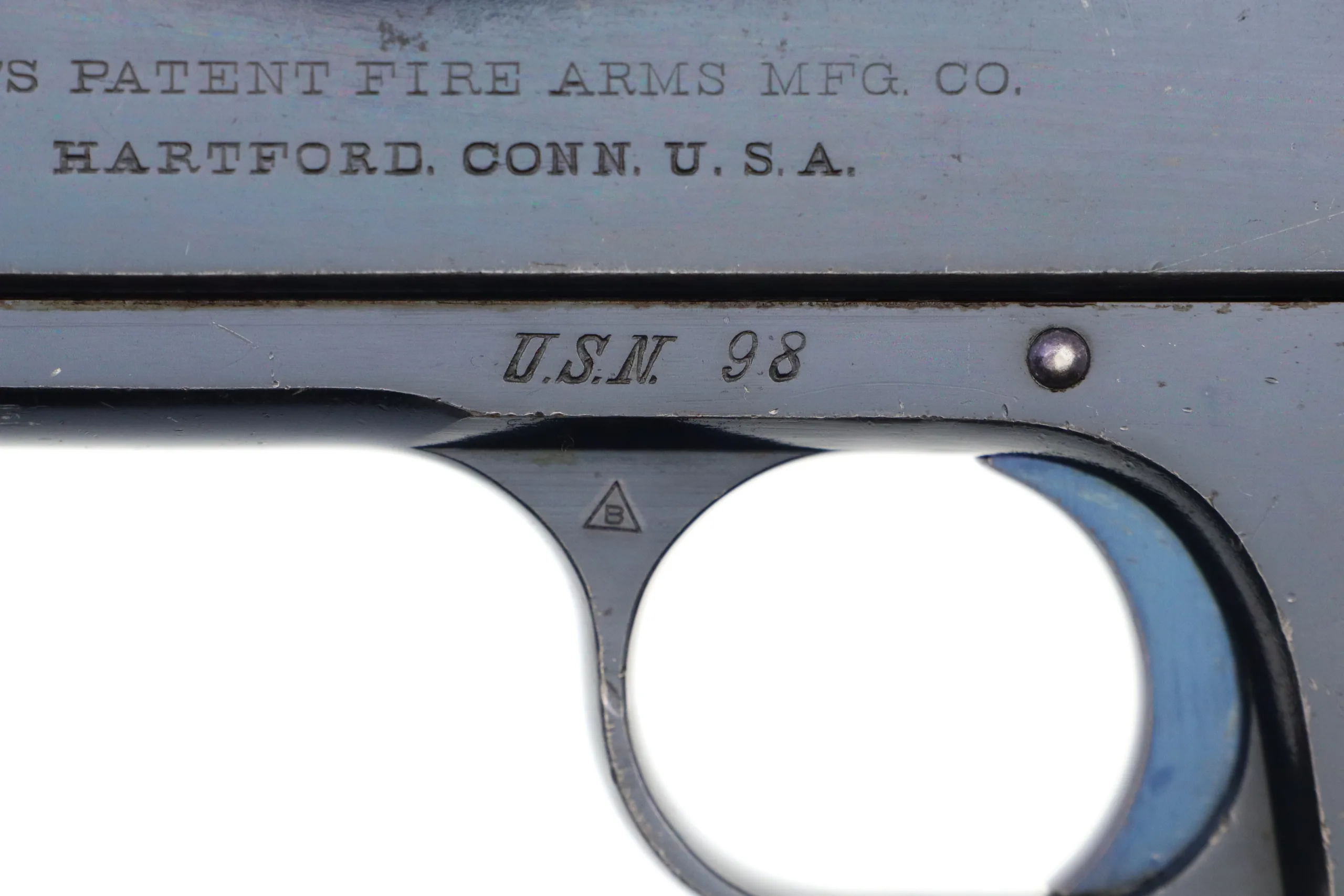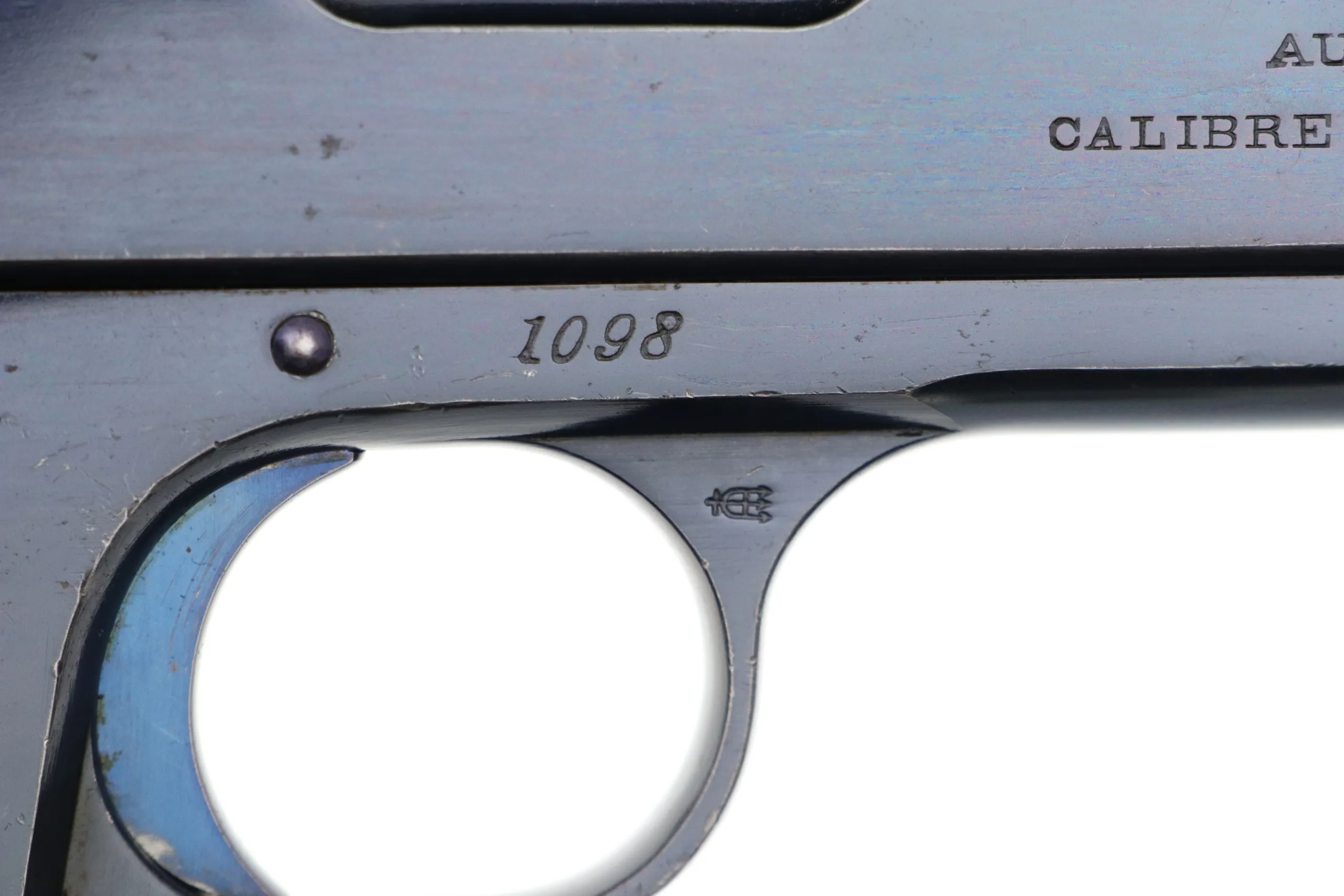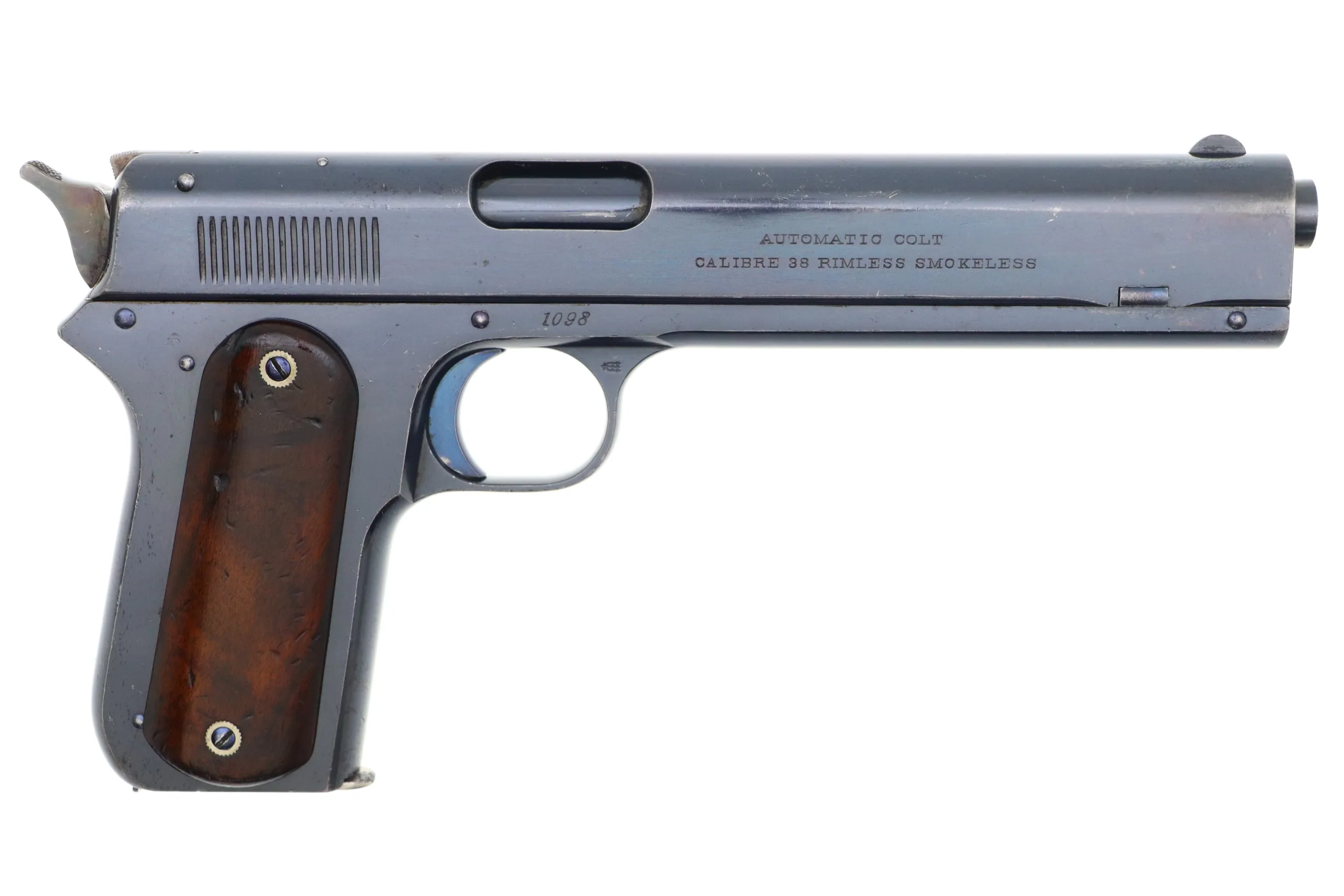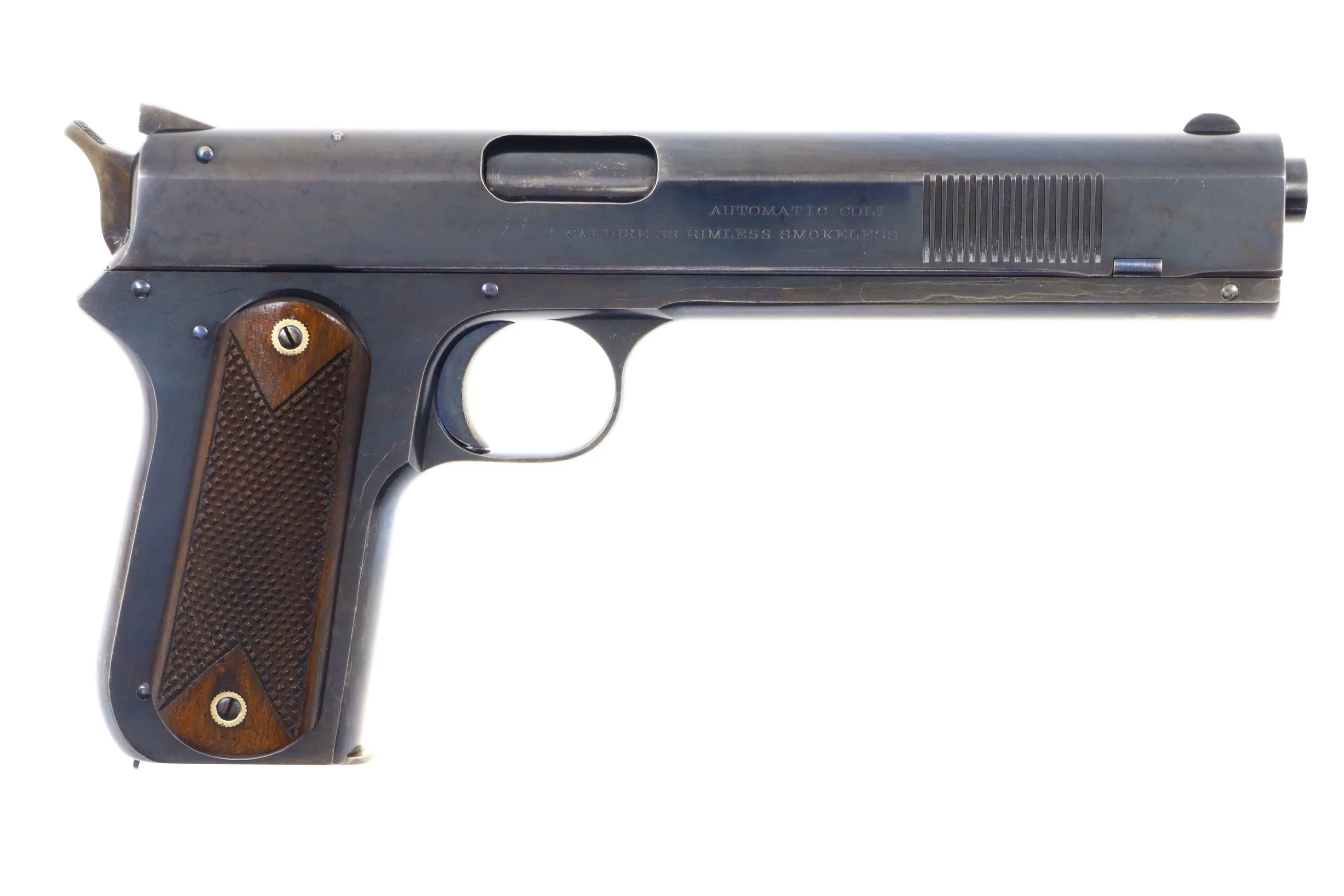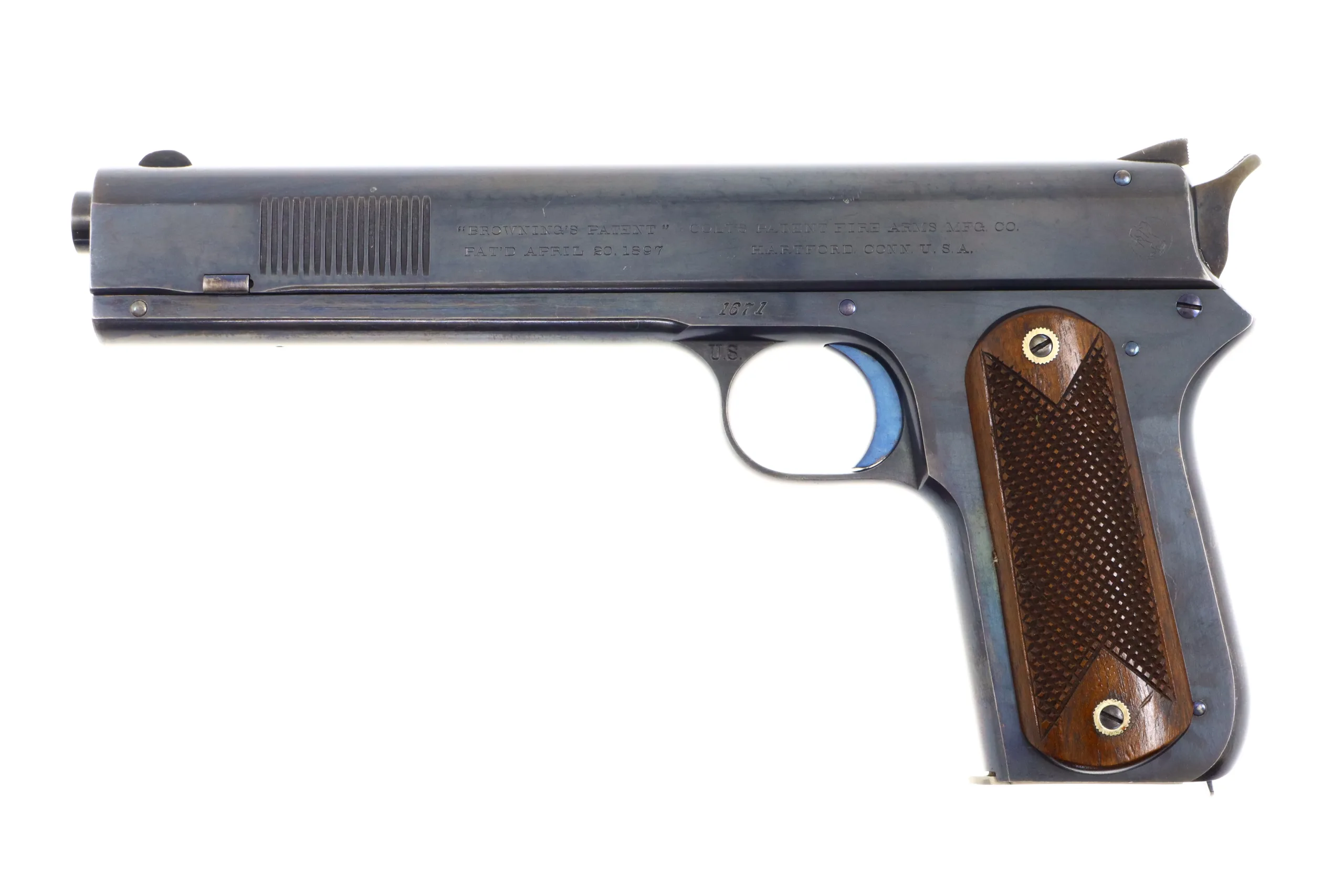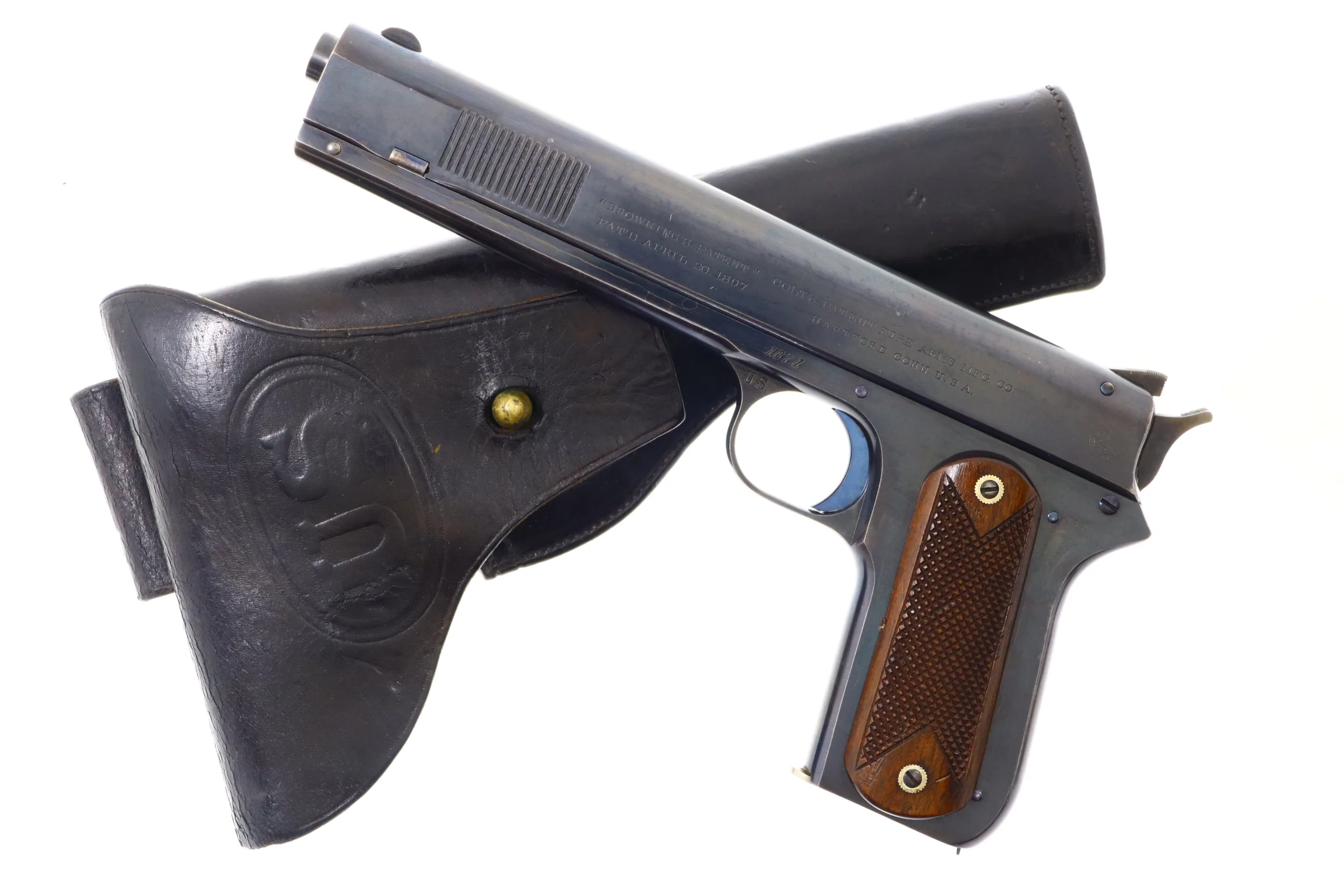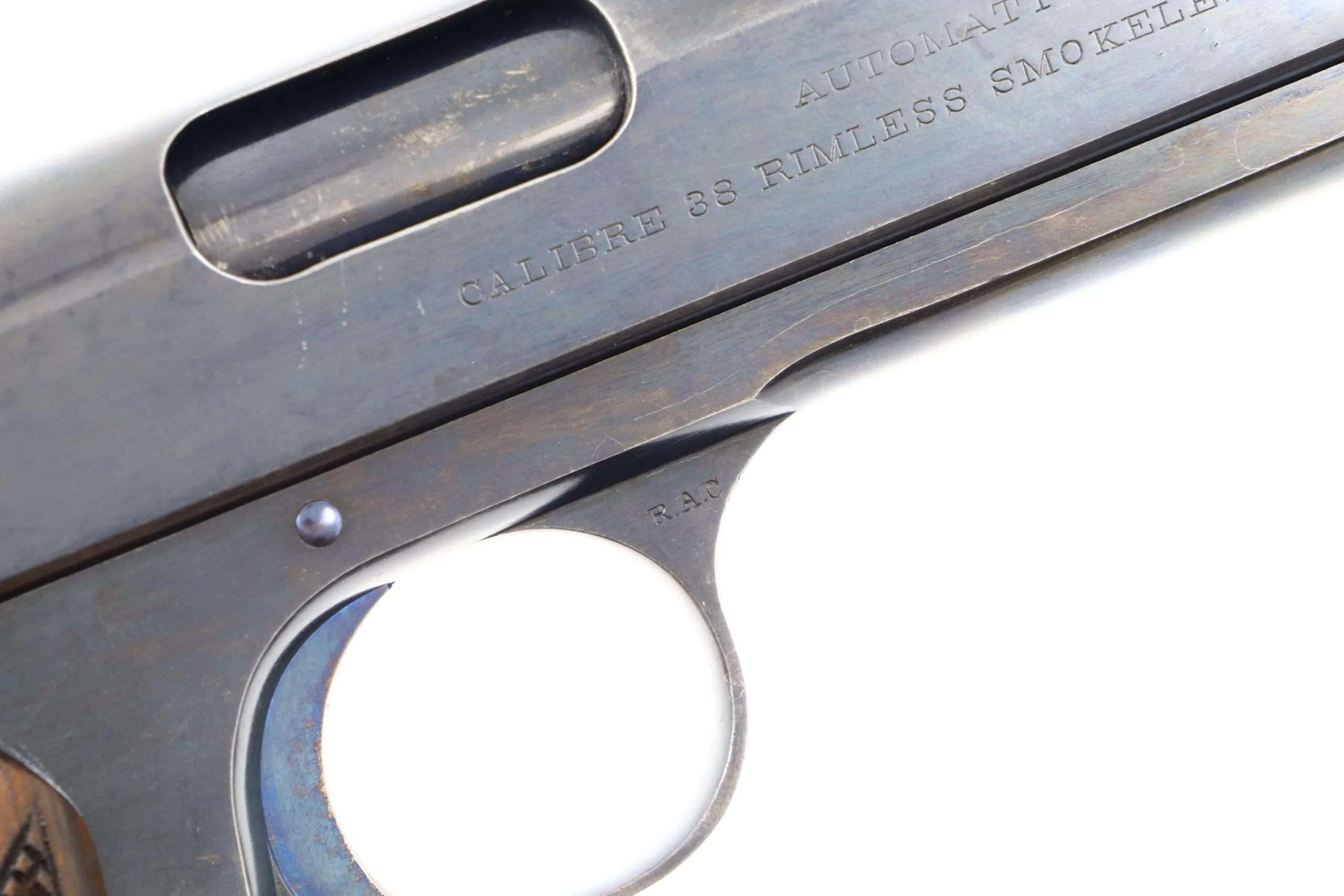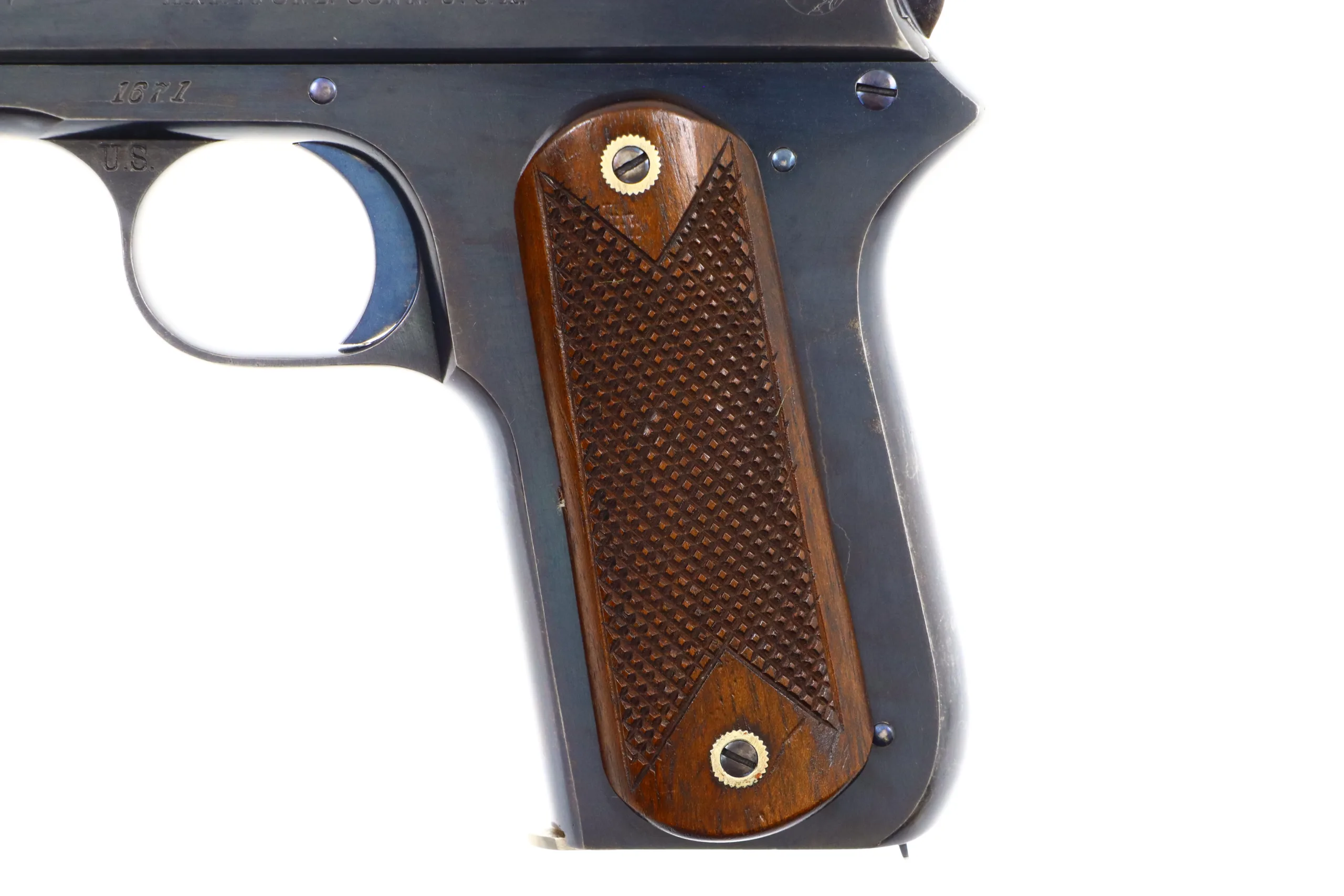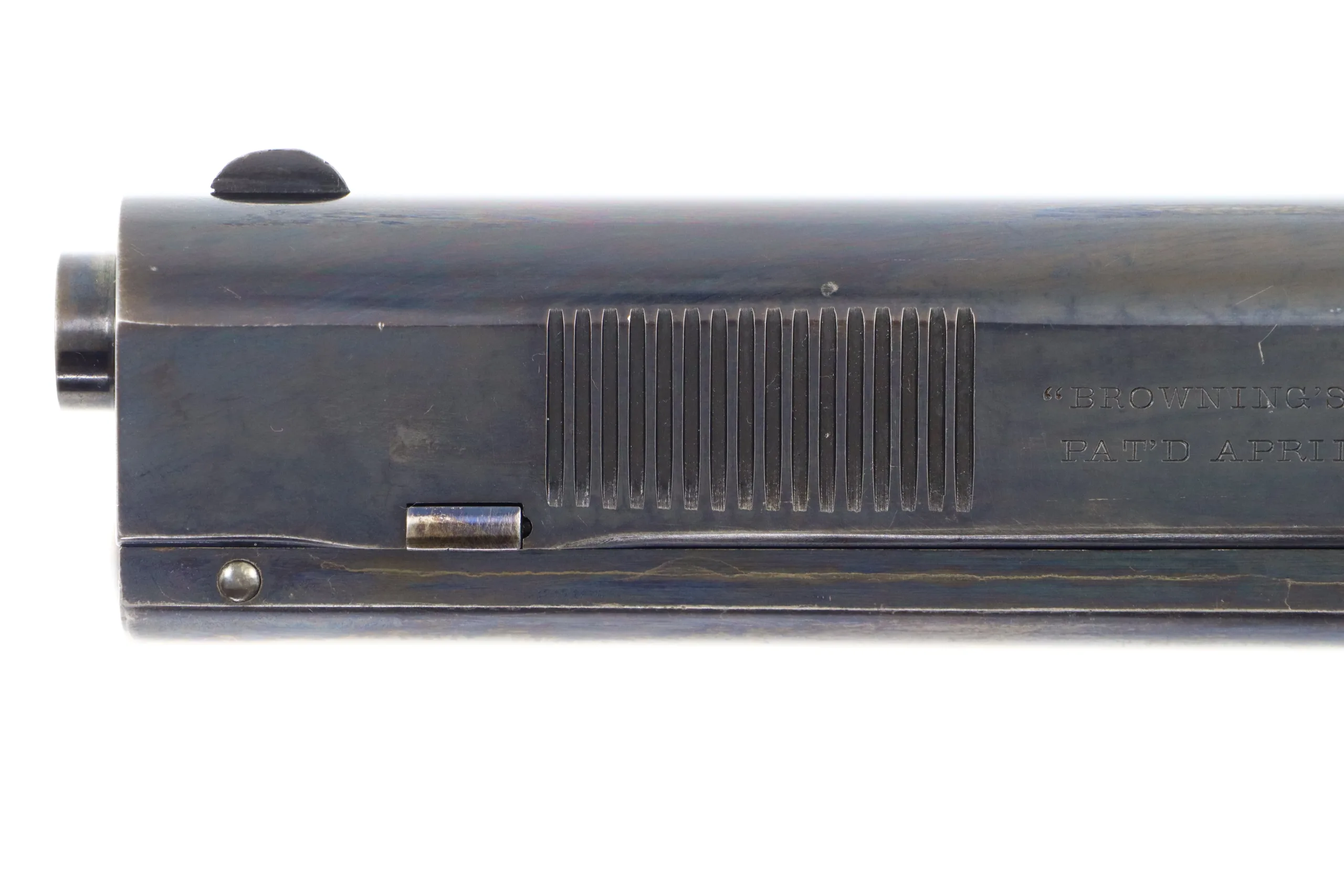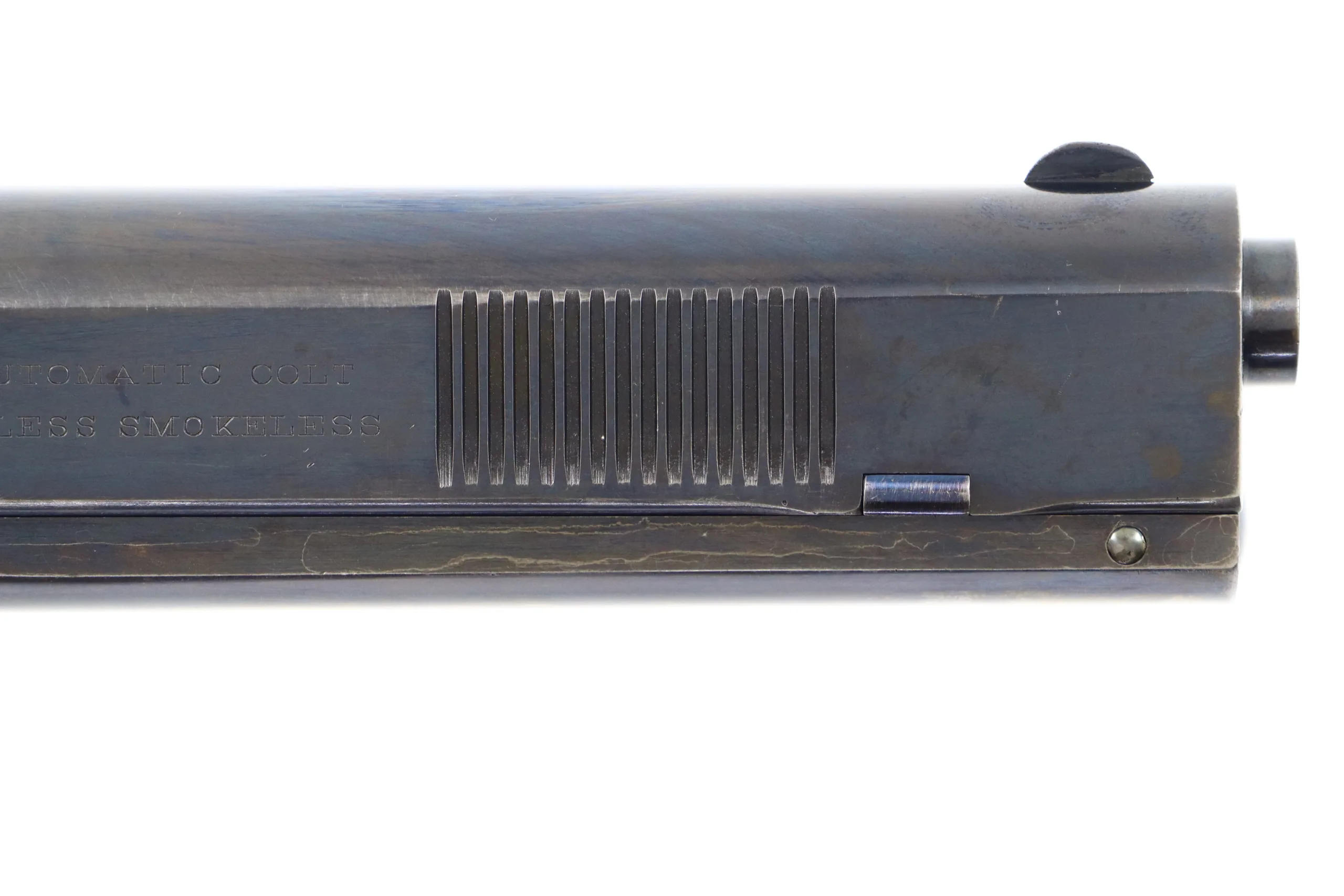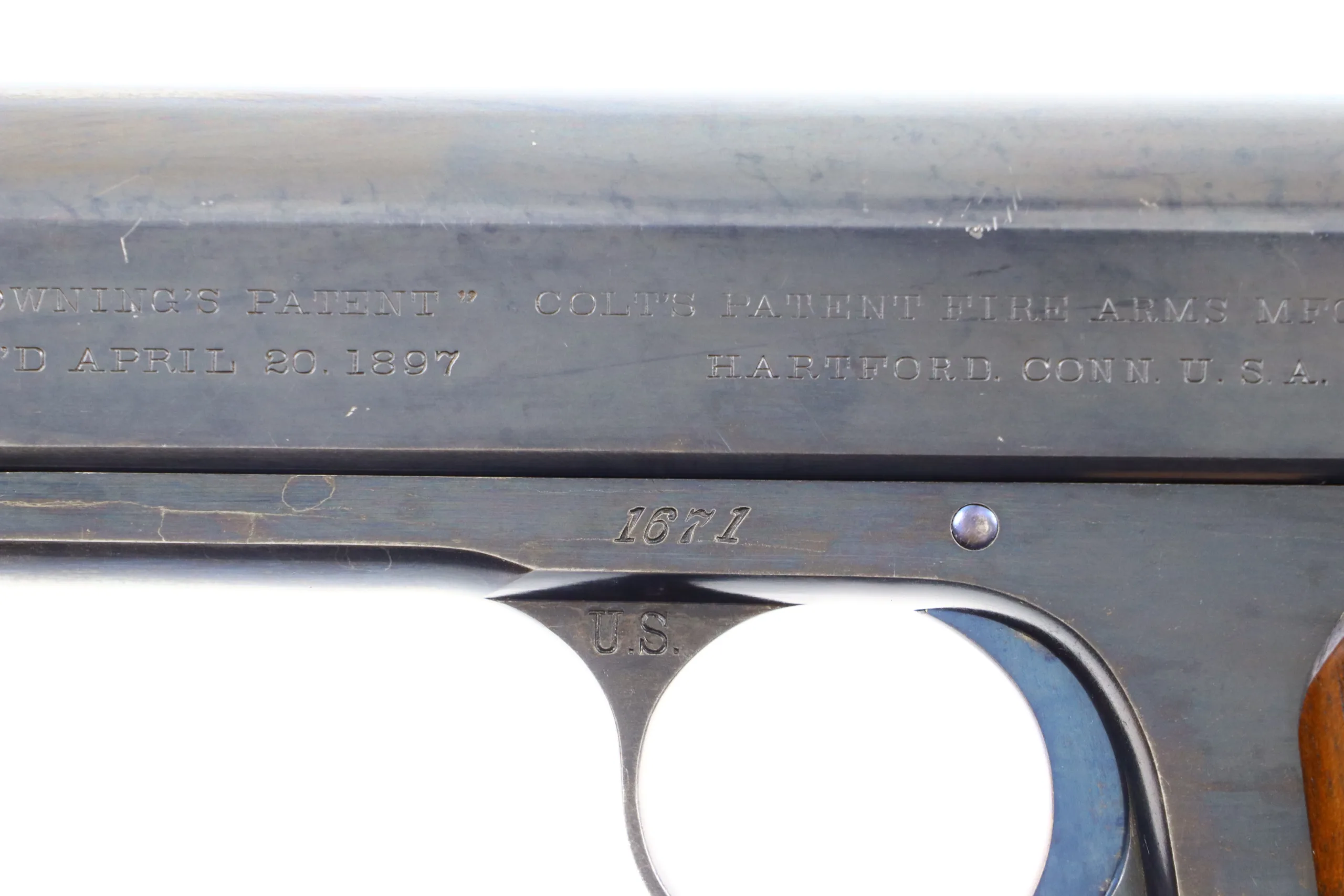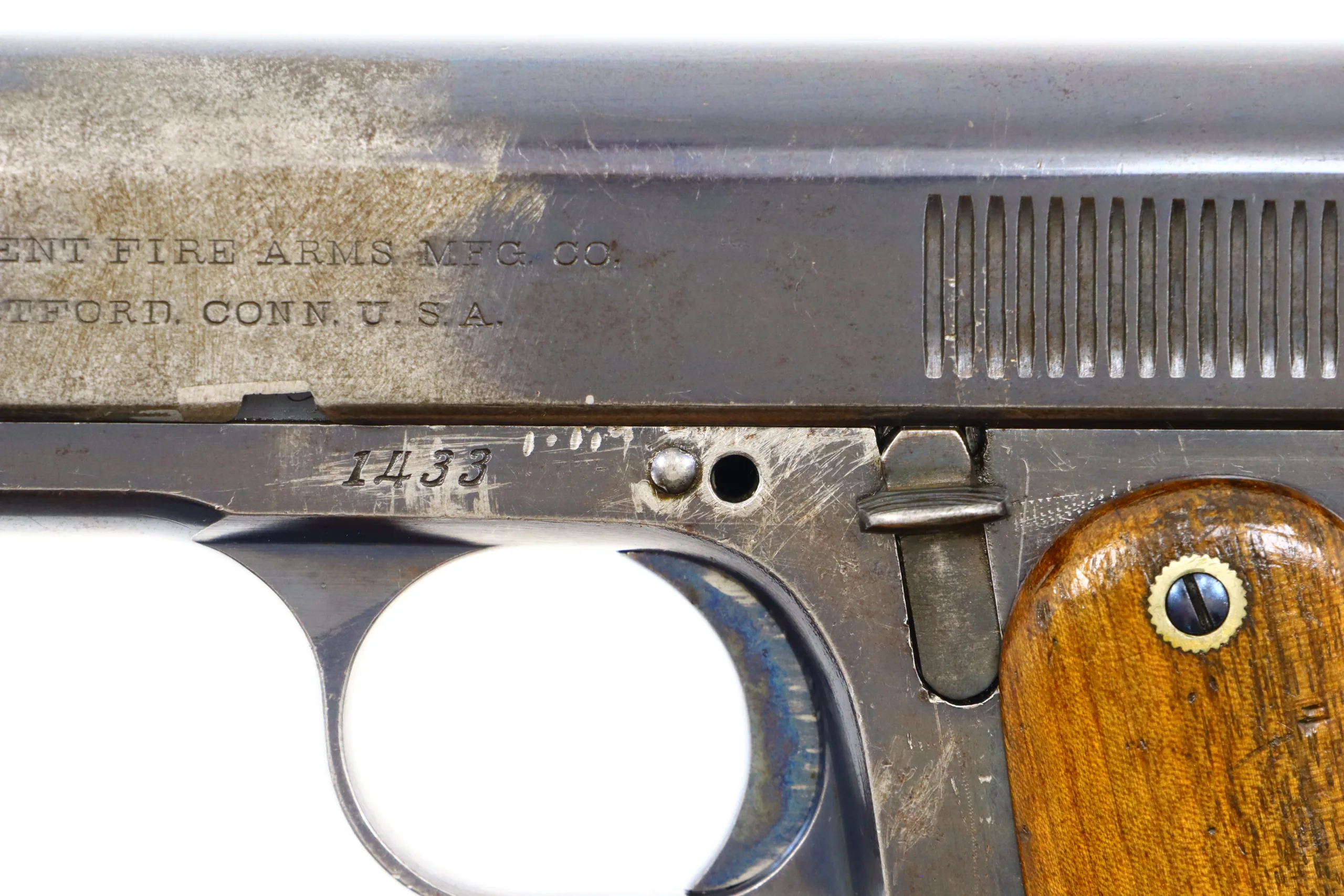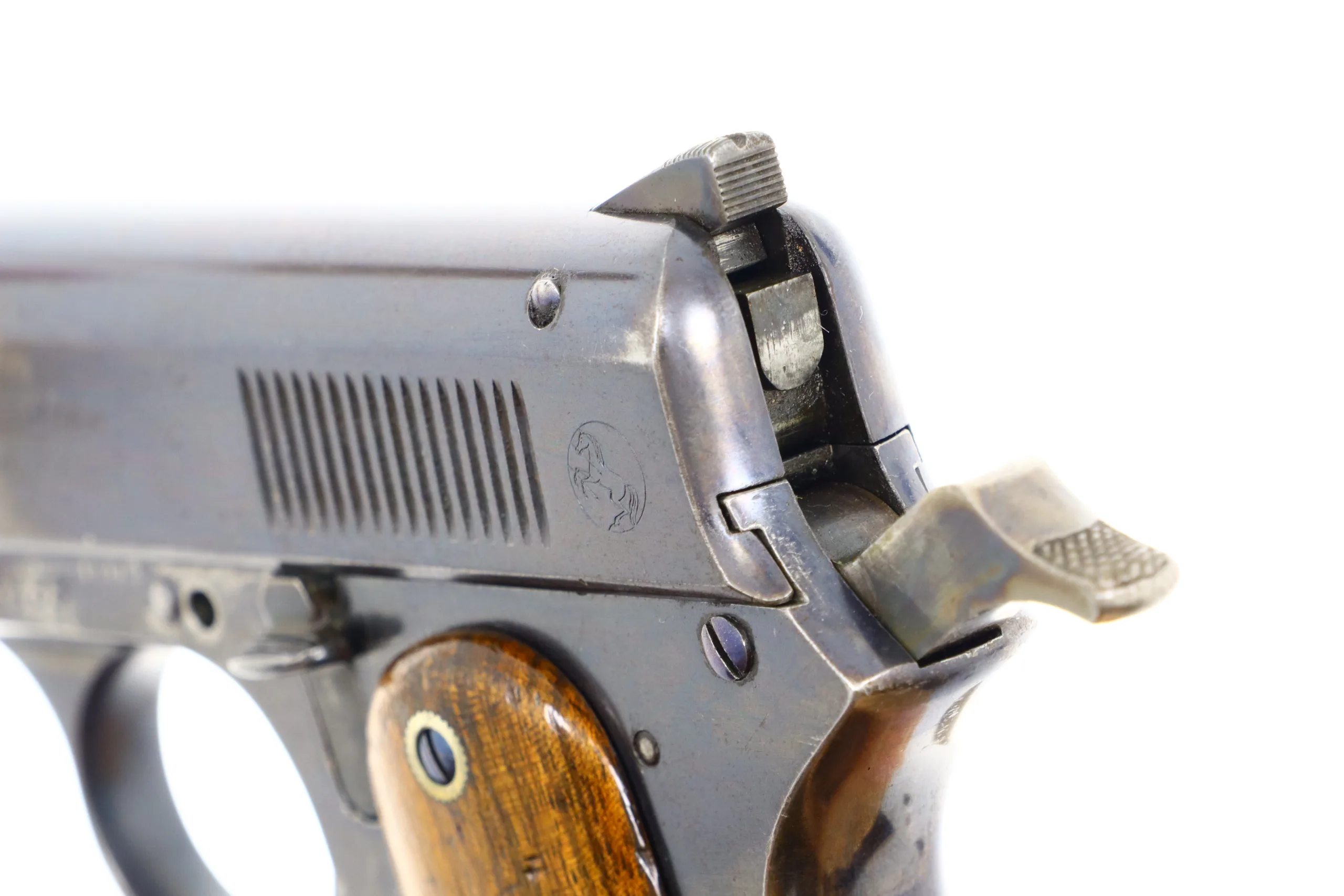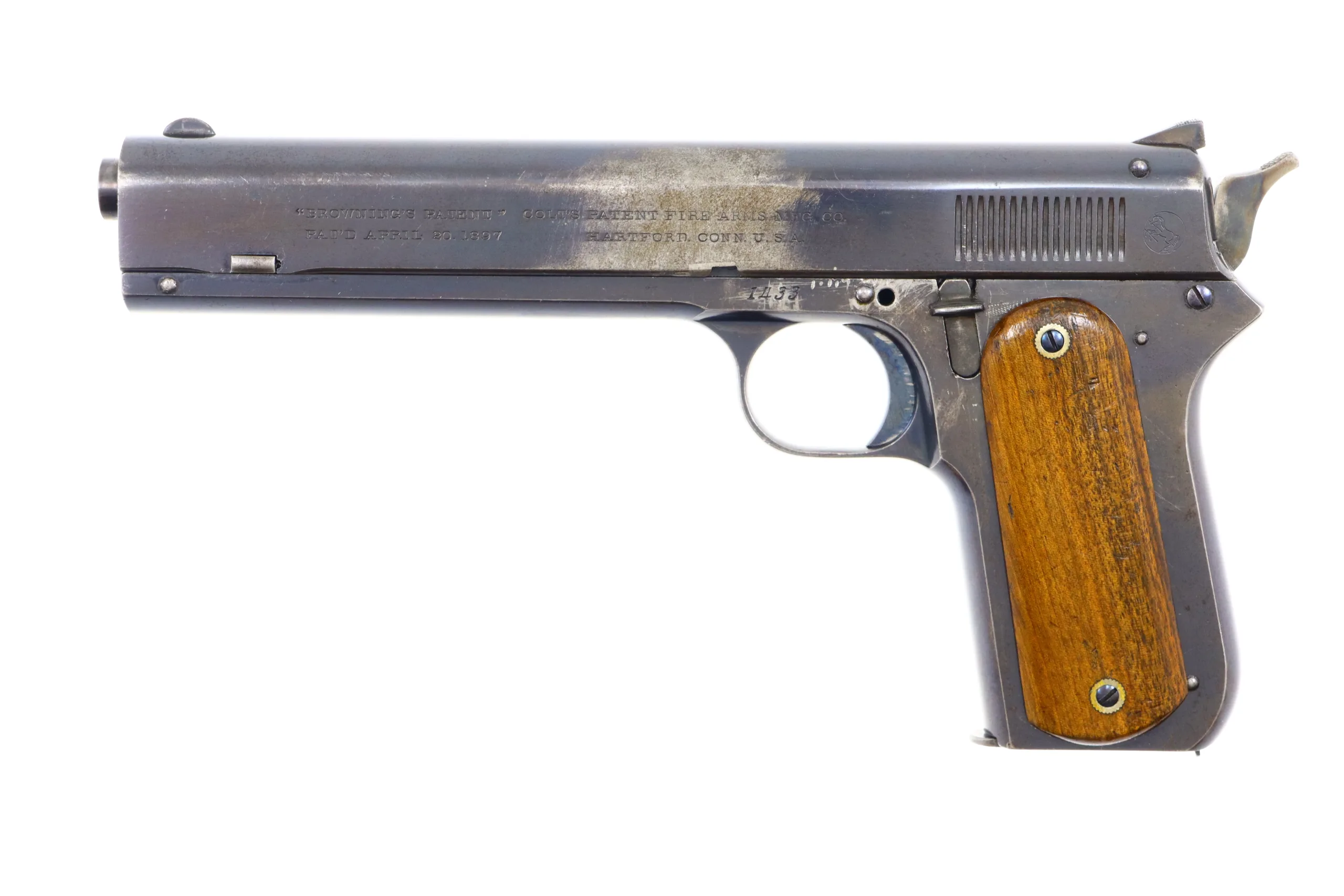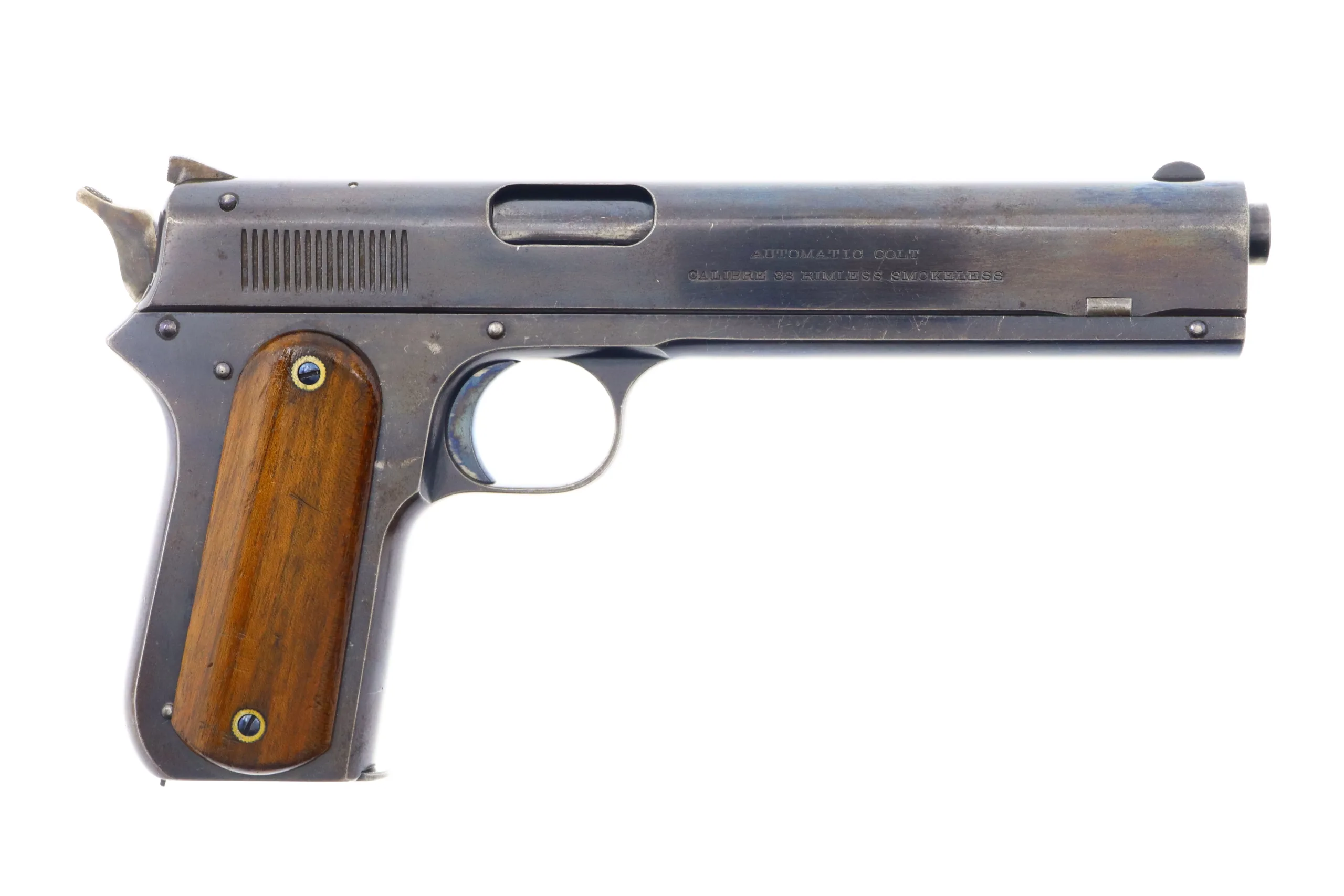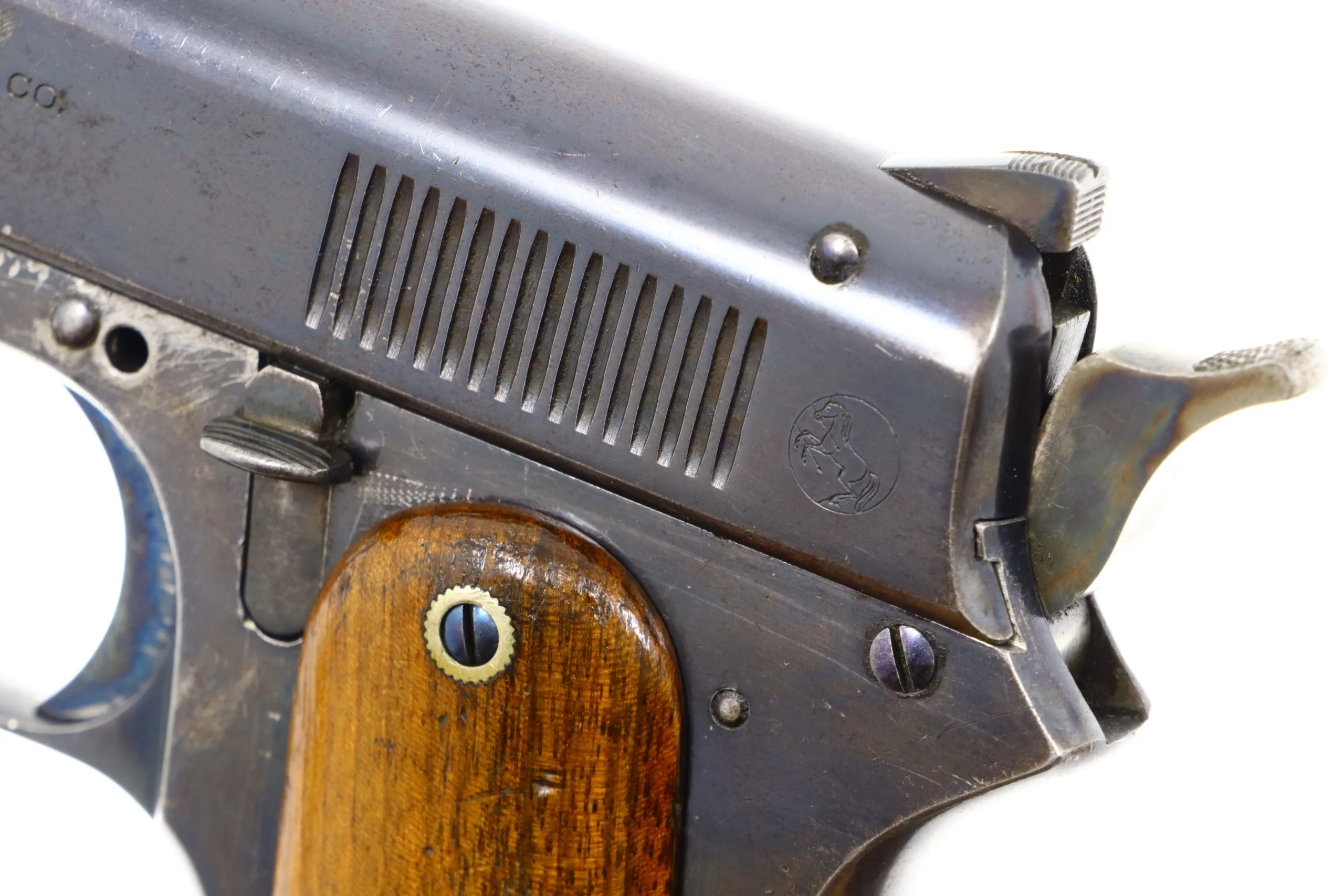Overview of the Colt Model 1900
The Colt Model 1900 was the first production model semi-automatic pistol in regular manufacture by Colt’s Patent Firearms Manufacturing Company and the first semi-automatic pistol officially presented in quantity for formal trail testing by the U.S. military. Designed by the legendary firearms inventor John Moses Browning, the Model 1900 laid the groundwork for future automatic pistols, particularly the iconic Colt Model 1911.
Development and Design
- Designer: John Browning
- Manufacturer: Colt’s Patent Firearms Manufacturing Co.
- Caliber: .38 ACP (Automatic Colt Pistol)
- Action: Short recoil, locked breech, single-action
- Magazine: 7-round detachable box magazine
- Sights: Early models had a “sight safety” (a combined rear sight and safety mechanism)
Key Features:
- Sight Safety: One of the most distinctive features of the earliest Model 1900 pistols. When engaged, the rear sight would act as a safety by blocking the firing pin. It proved unpopular and was later eliminated in revised versions.
- Slide Design: The Colt 1900 used a long slide with a rear-loading spring and dual locking lugs on the barrel.
- No Grip Safety: Unlike the later 1911, it did not have a grip safety or thumb safety.
The First Army Contract
Context
In the late 19th century, the U.S. military was exploring alternatives to its then-standard sidearms. Revolvers, such as the Colt M1892 in .38 Long Colt, were proving inadequate in stopping power during conflicts like the Philippine–American War. There was growing interest in automatic pistols due to innovations in self-loading firearm designs in Europe and America.
Initial Military Interest
- In 1900, the U.S. Army Ordnance Department became interested in evaluating semi-automatic pistols for military use.
- As a result, the Army placed a small procurement order with Colt to test Browning’s design.
Army Contract Details
- Date: April 1900
- Quantity Ordered: 100 pistols
- Serial Numbers: 11 to 207 (This first batch is often referred to as the First Army Contract)
- Designation: These were designated as the “Automatic Pistol, Caliber .38, Model of 1900”
- Purpose: For field testing and evaluation by troops
These pistols were issued to various cavalry units for field trials to assess their reliability, accuracy, and overall suitability for military use.
Field Performance & Feedback
- Soldiers generally found the pistol innovative, but noted several issues:
- The sight safety was criticized as awkward and potentially dangerous under stress.
- A desire for a longer grip.
- Wanted a lanyard ring.
- The gun was considered too complex compared to revolvers, and malfunctions were not uncommon during initial testing.
Despite the criticisms, the feedback played a crucial role in improving future designs. John Browning continued refining his pistol, leading eventually to the development of the Model 1902 and ultimately the Colt M1911.
Legacy
- The First Army Contract Colt 1900s are highly collectible today due to their historical significance and rarity.
- These pistols represent the first semi-automatic sidearms trialed by the U.S. military, even in an experimental capacity.
- They helped pave the way for the eventual adoption of the Colt Model 1911, which served as the U.S. military’s standard sidearm for over 70 years.
Variants and Evolution
After the initial contract, Colt continued producing commercial versions of the Model 1900, some with and some without the sight safety. These were eventually followed by the Model 1902 Military and Sporting Models, which improved upon the original design with stronger slides, better sights, and improved safety mechanisms.
Conclusion
The Colt Model 1900 First Army Contract was not just a first for the military—it marked a turning point in handgun development. Although it was not adopted as a standard service weapon, it was the first step in the transition from revolvers to semi-automatic pistols in U.S. service. Its direct influence can be traced all the way to the Browning-designed Colt 1911, a pistol that would become legendary in its own right.
The Colt Model 1900 Navy Contract pistol is a fascinating and historically significant firearm — it marked the first formal U.S. Navy procurement of a semi-automatic pistol, and one of the earliest semi-automatics tested by any U.S. military branch. This Navy contract helped validate John Browning’s design and paved the way for future military semi-auto adoption.
???? Overview
- Model Name: Colt Model 1900 Automatic Pistol
- Caliber: .38 ACP (Automatic Colt Pistol)
- Action: Short recoil, locked breech, single-action
- Designer: John M. Browning
- Manufacturer: Colt’s Patent Fire Arms Mfg. Co.
- Contracting Branch: U.S. Navy
- Contract Date: 1900
- Quantity Ordered: 250 pistols
- Serial Number Range: 1001 to 1250
???? Historical Context
At the turn of the 20th century, the U.S. military was beginning to experiment with semi-automatic pistols. Revolvers were still dominant, but recent innovations in firearm design, particularly those by John Browning, were drawing interest from the U.S. Army and Navy.
The Colt Model 1900 — Browning’s first successful semi-auto pistol produced by Colt — had recently launched in both commercial and limited military forms. The U.S. Army had already placed a small “First Army Contract” for 100 pistols in April 1900, and the U.S. Navy followed soon after, ordering 250 pistols for evaluation and limited issue.
???? The Navy Contract
????️ Contract Details:
- Date of Order: Mid to late 1900
- Quantity: 250 units
- Purpose: Formal evaluation and testing by Navy personnel
- Delivery: Within the same year (1900), shipped directly from Colt
???? Features Specific to Navy Contract Pistols:
- Frame marked “U.S.N.” on the left side with naval number 1-250.
???? Design Features (Model 1900 Navy Variant)
- Caliber: .38 ACP – powerful for its time (velocity ~1,250 fps)
- Magazine: 7-round, single-stack, detachable
- Barrel Length: 6 inches
- Frame: Smooth-backed grip, wood panels
- Sight Safety: A rear-sight that doubled as a manual safety (often considered awkward and potentially unsafe)
- No grip safety or thumb safety – both would be added in later models (1902 onward)
⚠️ Feedback and Issues:
- The sight safety was widely disliked for being difficult to engage/disengage quickly
- Reliability was fair, but there were occasional feeding and ejection issues
- The .38 ACP cartridge, while fast, lacked the stopping power desired for a military
???? Legacy and Impact
While not officially adopted as a standard service pistol, the Navy contract for the Colt 1900 was historically significant:
- It marked the first U.S. Navy use of a semi-automatic pistol
- It validated the basic design and viability of Browning’s semi-automatic platform
- It encouraged further refinements by Colt and Browning — leading to the 1902, 1905, and ultimately the 1911
✅ Summary
The Colt Model 1900 Navy Contract was:
- The first semi-automatic pistol formally issued by the U.S. Navy
- A limited but critical early step in U.S. military small arms evolution
- Part of the lineage that led directly to the legendary Colt M1911
Though only 250 were made, these pistols represent an important bridge between revolvers and modern handguns in U.S. service.
Approximately 4,274 Model 1900 pistols were manufactured between February 1900 and May of 1902.
The Colt Model 1900 Second Army Contract pistol is a rare and historically significant follow-up to the first semi-automatic handgun ever tested by the U.S. Army. While often overshadowed by the better-known First Army Contract, the Second Contract played a pivotal role in evaluating and improving early semi-automatic pistol technology for military use.
Below is a detailed history:
???? Second Army Contract: Origins
???? Timeline:
- Date of Contract: Late 1900 (approx. November or December)
- Quantity Ordered: 200 pistols
- Serial Numbers: Serial No. 1501 to 1700
- Designation: “Automatic Pistol, Caliber .38, Model of 1900”
- Purpose: Further field trials by cavalry and artillery units following mixed results from the First Contract.
- Shipped: December 28, 1900 to February 4, 1901
???? Reason for Second Contract:
The First Army Contract (100 pistols) had been issued earlier in 1900 for testing. While soldiers were impressed by the concept and some features, they noted design flaws—especially in the “sight safety”, which doubled as a rear sight and safety mechanism. Other concerns included ammunition performance and unfamiliarity with semi-automatic operation.
The Second Contract was initiated to:
- Gather additional troop feedback
- Evaluate updates in design
- Confirm whether changes improved performance and reliability
???? Technical Features
The Second Army Contract pistols were mechanically identical to most of the First Contract models and commercial versions:
- Slide serrations were moved to the front and made longer and deeper
- The grips were made thicker and checkered
⚠️ Results of Field Testing:
- Mixed reviews from the field
- Ongoing issues with stoppages
- Some failures to properly feed ammunition
- Persistent complaints about the sight safety being hard to use and potentially dangerous in combat
Despite the Second Contract trials, the military still felt the system was not yet ready for full service adoption, especially compared to simpler, rugged revolvers.
???? Influence and Aftermath
The Second Army Contract contributed valuable feedback that helped shape:
- The evolution of the Model 1902 Military and Sporting Models
- The eventual creation of the Model 1905
- The final and most successful iteration: the Colt Model 1911, adopted in 1911 after further trials
???? Browning continued refining the action, ergonomics, and safety systems. Many of the problems in the 1900 models were directly addressed in these subsequent designs.
???? Historical Significance
- Rarity: Second Army Contract Colt 1900 pistols are exceedingly rare
- Military Markings: Some have inspection stamps such as “J.T.T.” (John T. Thompson) and “RAC” (Rinaldo A. Carr), U.S. government inspectors of the period.
- Transition Piece: The Second Contract represents a crucial step between experimental trials and full military adoption of semi-automatic pistols.
Slide lock Prototype
Serial Number 1433, Model of 1900 Browning Slide Lock Prototype, was a regular production Model 1900 shipped to John Browning on January 4, 1901. Browning had designed the slide lock and then took this pistol out of his store’s inventory to work on creating the mechanism as a working model. The purpose being to lock the slide back on the last shot to assist with reloading, to address concerns expressed in the trials regarding the need to use 2 hands to reload the pistol. This design feature was one of the many key developments that Browning made on his and Colt’s path to creating the Model 1911. The patented slide lock demonstrated on Serial Number 1433, was one of the new elements incorporated into the next Colt model, the Model of 1902.



